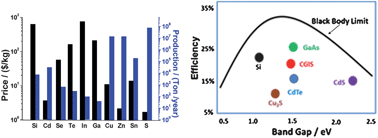The development of copper chalcogenide based nanomaterials as promising candidates for sustainable energy materials, due to their environmental compatibility and low toxicity, is presented and discussed in this review. Different solution syntheses have recently been developed for the low-cost preparation of copper chalcogenide nanocrystals, and their unique properties derived from copper deficiencies were investigated with much progress. The notorious compositional instability and defect formation of copper chalcogenide nanocrystals have been healed by forming donor–acceptor pairs in ternary and quaternary chalcogenide based nanocrystals, especially in copper zinc tin sulfides (CZTS). In addition to their use as light absorbers in solar cells, copper chalcogenide nanocrystals have also been utilized in different applications, such as electrode materials in Li ion batteries and high efficiency counter electrodes in dye/quantum dot sensitized solar cells as well as for NIR photothermal therapy. All relate to their unique copper deficiency properties. The copper chalcogenide based nanomaterials are believed to be sustainable materials for future energy applications once the syntheses and property investigations have led to a more complete understanding of their physics.

You have access to this article
 Please wait while we load your content...
Something went wrong. Try again?
Please wait while we load your content...
Something went wrong. Try again?


 Please wait while we load your content...
Please wait while we load your content...